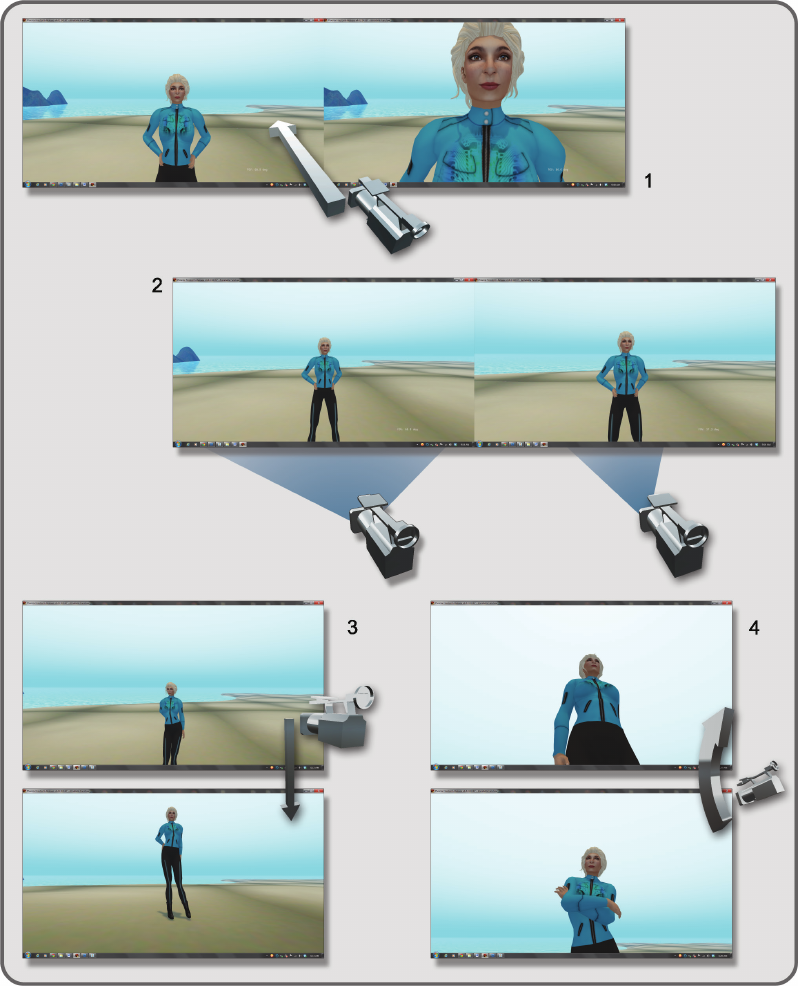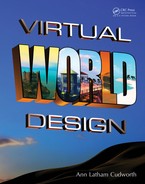
325Machinima in Virtual Worlds
FIGURE 16.7 Camera narrative in shots related to distance of camera from subject. There are seven basic kinds
of shots: (1) Extreme wide: “Here is where our story starts/ends.” (2) Wide: “Wow, look at all the people around.”
(3)Medium: “Who is that interesting person?” (4) Tight, half body: “I am really interested in them.” (5) Head shot:
“Sheis looking at me!” (6) Close up: “I think she likes me!” and (7) Extreme close-up: “I think she loves me.”

326 Virtual World Design
FIGURE 16.8 Camera narrative related to camera angle. There are 6 basic kinds of shots: (1) Eye line: “I am your
equal.” (2) Low, under chin: “I am your subordinate.” (3) High, above eye line: “I am your superior.” (4) Worm’s eye:
“You are really important/I am really unimportant or I am invisible.” (5) Bird’s eye: “I know all; you are my prey.”
(6)Dutch tilt: “I am confused; I am tilting my head to understand.” This shot is also known as Dutch angle, oblique
angle, German angle, canted angle, or Batman angle.

327Machinima in Virtual Worlds
FIGURE 16.9 Camera moves as related to narrative quality. The three shown in this gure are: (1) Static shot: “The
world is all out there; I see it all.” (2) Dolly track left/right, straight line (crab): “I am moving through the space timeline.”
(3) Pan left/right, swish pan: “What—over there?”

328 Virtual World Design
FIGURE 16.10 Camera narrative related to camera moves. The 4 moves shown in this gure are: (1) Push in,
pullout:“You want a piece of me?” (2) Zoom in, zoom out: “I really want to know what you are thinking.” (3) Ped up
and ped down (moving the pedestal of the camera): “I think I will look at/hide from someone.” (4) Tilt up and tilt down:
“Hearwhat I am saying and look at what I am showing you.”
329Machinima in Virtual Worlds
In Figure16.9, there are the following shots:
1. Static shot: “The world is all out there; I see it all.”
2. Dolly track left/right, straight line (move like a crab): “I am moving through the space timeline.”
3. Pan left/right, swish pan: “What—over there?”
Figure16.10 has the following shots:
1. Push in, pull out: “You want a piece of me?”
2. Zoom in, zoom out: “I really want to know what you are thinking.”
3. Ped up and ped down (moving the camera pedestal): “I think I will look at/hide from someone.”
4. Tilt up and tilt down: “Hear what I am saying and look at what I am showing you.”
16.3.4 sCripTs and sToryBoards: Why They are CruCial To your suCCess
The backbone of your project, and its “spirit guide,” is the script (or backstory or written play). The manual
for the assembly of your camera images into a machinima is the storyboard. Both of these are essential for
any machinima project. They will help you plan your project, and that planning saves time and money.
Let’s suppose you have decided to make a machinima based on the timeless plot of a rags-to-riches story.
Cinderella, Aladdin, and other favorite childhood stories follow this plotline. Essentially, there are three acts
in these stories. Act 1 is about the hero’s (or heroine’s) life, which may or may not be an unhappy one. Act 2 is
about how the hero is introduced to the possibility of a wealthy life but is prevented or distracted from achiev-
ing that life by events and actions of other characters in the story. In Act 3, the hero attains the monetary or
spiritual wealth in accordance with the changes made in their natures by the events that have transpired. This
plot is your guide, along with the events, characters, and their social interaction inside the story. It is your job
as the machinimatographer to show the audience what these are, to create a visual story from the sequence
of actions and interactions in the story.
You can do this by breaking down each act into “scenes.” If you list them and the location where they
take place, a pattern will emerge. For instance, for Cinderella, you may have a list of scenes and locations
that look like this:
Act 1
Scene 1: Cinderella’s childhood, father dies, leaves her with evil stepmother.
Location is grove of woods by Father’s grave.
Scene 2: Cinderella’s current position as maid to two stepsisters and stepmother.
Location is the kitchen of stepmother’s house.
Scene 3: Royal ball invitations come to the house, and all but Cinderella prepare.
Location is the drawing room of the stepmother’s house.
Scene 4: Fairy godmother helps Cinderella attend the royal ball.
Locations are Cinderella’s room and exterior of stepmothers’ house.
Act 2
Scene 1: Cinderella arrives at the ball and attracts the attention of the prince.
Location is the ballroom of the royal palace
Scene 2: The prince and Cinderella fall in love; it gets late, and she leaves him abruptly.
Location is the garden terrace of the royal palace.
Scene 3: The prince, left with a glass slipper, vows to nd the mysterious Cinderella.
Location is the steps of the royal palace
..................Content has been hidden....................
You can't read the all page of ebook, please click here login for view all page.
